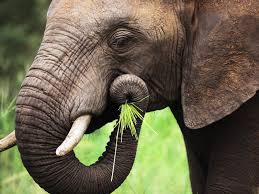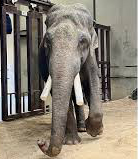Elephant with a toothache
When female Asian elephant “Swarna” joined the Washington Zoo herd in May 2014, her routine tooth exams showed an unusual shape and wear pattern on her teeth. Recently, the 46-year-old elephant appeared to have difficulty chewing her food properly. An elephant goes through six sets of molars in a lifetime. As one set wears down from grinding and chewing plant material, the next set pushes through. After an elephant’s last set of teeth wears down, they lose the ability to chew and digest food. Therefore, one of the leading causes of death in mature elephants is the loss of teeth. To ensure dental health, elephants are trained to lift their trunks and open their mouths so that Care Staff can inspect their teeth. The Vet team takes routine photographs of each elephant’s mouth monthly using an Endoscope and Caregivers work with the elephants regularly to maintain the behaviors required for this process using a Dewalt plumber’s camera. An elephant gets rewarded for participating in their dental care—and they receive higher value rewards—like a favorite kind of produce—for higher-level activities.
The elephant care team decided surgery was the best option for alleviating Swarna’s ailment. Through comprehensive training, they acclimated Swarna to the steps of the procedure. This built her trust and confidence and helped minimize the stress she may have experienced. Aging elephants in zoos are challenged with geriatric issues. Sharing information about diseases and treatment options with other zoos is beneficial for the population in human care as a whole. Our commitment to the care and study of Asian elephants at the Zoo is part of a larger conservation program to protect Asian elephants in their native habitat.
The big front tusks are an elephants’ incisor teeth and are used for defense, digging for food and water, and carrying and lifting. In addition to their tusks, elephants also have four molars inside their mouths. Elephants are herbivores. As they spend 22 hours a day chewing vegetation, they need their really big, strong, ridged, back teeth. While people’s teeth grow either up or down from the jawbone, an elephant’s molars grow in from the back of the jaw. There is one tooth for each quadrant that moves towards the front and is replaced when worn down. An elephant will have six sets of four molars in its lifetime. Occasionally an elephant may be lucky and have seven sets. Each time the teeth change, the new set is bigger. An elephant molar can be about 10 inches long, and weigh 5 pounds. You can watch in the video below, elephant dentistry specialists from the Colyer Institute joined the Zoo’s team to remove the culprit tooth. Since her surgery, Swarna has put on weight — a clear sign the elephantine-sized efforts were a success.
Elephants never forget
Dentist always dumb questions like, “When’s the last time you flossed?”
Like bro, you were there.
I just went on a date with a dentist receptionist, it went quite well.
We’ve arranged a second date for August 24th, 2024 at 7:15pm.
What do you call an elephant dentist?
A plaquey-derm.
A lady goes to the dentist with a sore tooth.
The dentist looks and says, “You have a bad tooth we are going to have to pull it.”
The lady says “I would rather be pregnant than have a tooth pulled.”
The dentist replies “Make up your mind, I have to adjust the chair”
May 16th Birthdays
1966 – Janet Jackson, 1986 – Megan Fox , 1973 – Tori Spelling, 1955 – Debra Winger
1970 – David Boreanaz, 1969 – Tucker Carlson, 1982 – Joseph Morgan, 1953 – Peirce Brosnan




